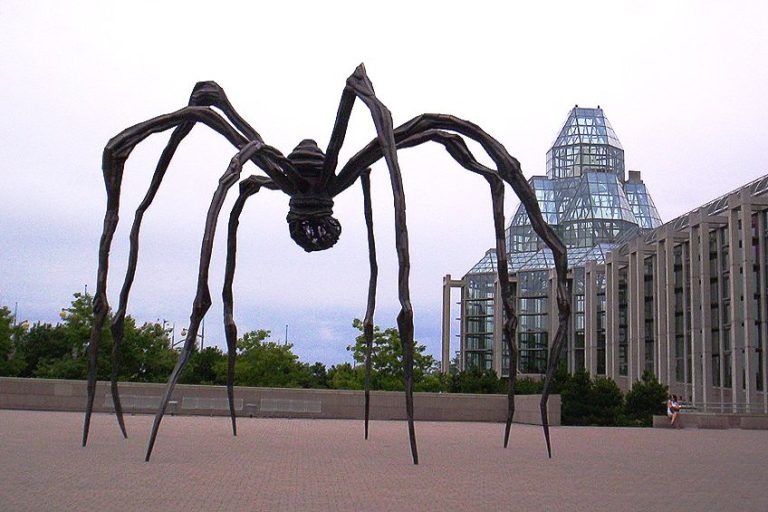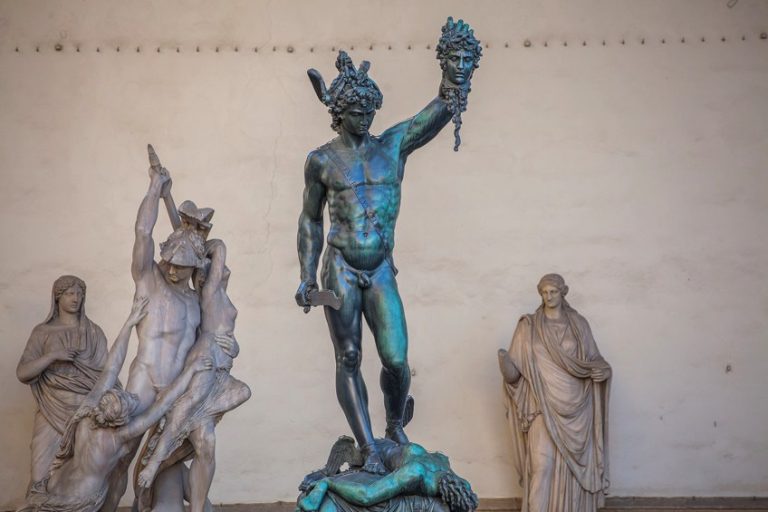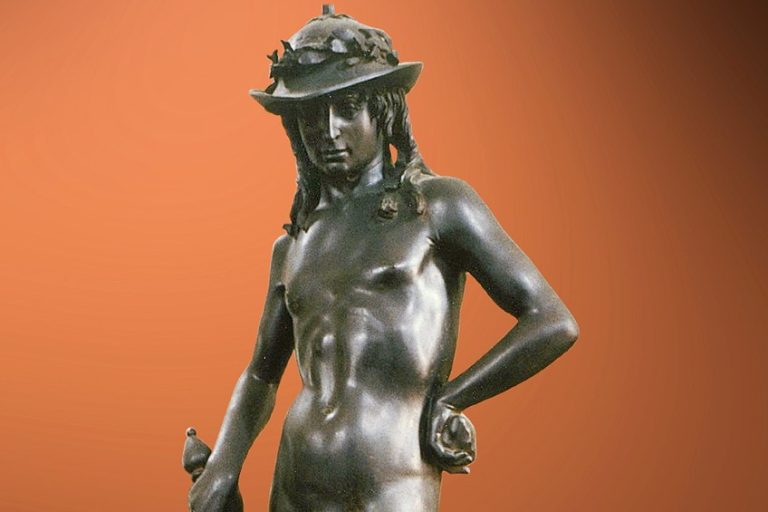“Gates of Paradise” by Lorenzo Ghiberti – The World-Famous Bronze Door
The Gates of Paradise by Lorenzo Ghiberti depicts several Old Testament texts through a sequence of sculpted, gilded panels that come together to make this magnificent set of Renaissance period bronze doors. The Gates of Paradise in Florence was the designer’s second pair of bronze doors, having previously finished the less well-known but nonetheless noteworthy North Doors (1403). The Gates of Paradise by Lorenzo Ghiberti took 27 years to create, an astounding amount of time in today’s world, but a fair amount of time to create such a masterpiece in the Renaissance period.
Table of Contents
Exploring The Gates of Paradise by Lorenzo Ghiberti
After his debut series of doors, Ghiberti became a sought-after artist, which meant that he was regularly working on many pieces at the same time. This reveals why, even with the assistance of his highly regarded workshop helpers, this pair of bronze doors took so long to complete. The Gates of Paradise in Florence had various characteristics that rendered them exceptionally noteworthy in the history of art during the Renaissance period. Many subsequent creators would learn from and admire his accomplishments, incorporating pieces of his works into their own.
This was the standard flow of creative ideas at the period, with Donatello, an alumnus of Lorenzo Ghiberti who went on to become one of the most revered sculptors of all time.

An Introduction to the Artist: Lorenzo Ghiberti
| Nationality | Italian |
| Date of Birth | 1378 |
| Date of Death | 1 December 1455 |
| Place of Birth | Pelago, Italy |
Lorenzo Ghiberti started his career as a goldsmith, but he quickly gained a name in Florence for his mastery in bronze sculptural work, which was then a costly and highly valued material. Ghiberti created his own castings using the direct lost-wax process, which entailed producing a wax figure with a clay center, covering it with clay, and baking it to melt off the waxes so that the area left could be refilled with melted bronze.
Ghiberti’s knowledge of metal, nevertheless, was demonstrated in his capacity to finish a cast object, that is, to use filers, cutting tools, and pumice stone to eliminate defects and give the metal life.

Ghiberti’s study of historical and modern art provided motivation for what to do with these artisan abilities. The sculptor was a devoted study of antiquity’s extant art, particularly classical artists’ obsession with human biology and proportion. He even has his own modest antique collection. Other sculptors who influenced him included Donatello, who worked as an intern to Ghiberti earlier in his career.
Ghiberti also drew inspiration from the popular International Gothic Style and metalworkers he visited in Northern Europe, notably German craftspeople.
The Gates of Paradise (1452) in Florence
| Date Completed | 1452 |
| Medium | Gilded bronze doors |
| Dimensions | 5.18 meters |
| Location | Baptistry of Florence |
Between 1425 and 1452, Lorenzo Ghiberti sculpted the Gates of Paradise, which were put in the Baptistery’s eastern gate. Centuries of sculptors and art historians have lauded the Gates for their captivating depictions of Old Testament themes. The famous bronze doors became an emblem of the Renaissance period and one of the most recognized pieces of art on earth over time.
The craftsmanship of the panels reveals that by the early 15th century, Florentine artisans had perfected linear perspective and the classic style.
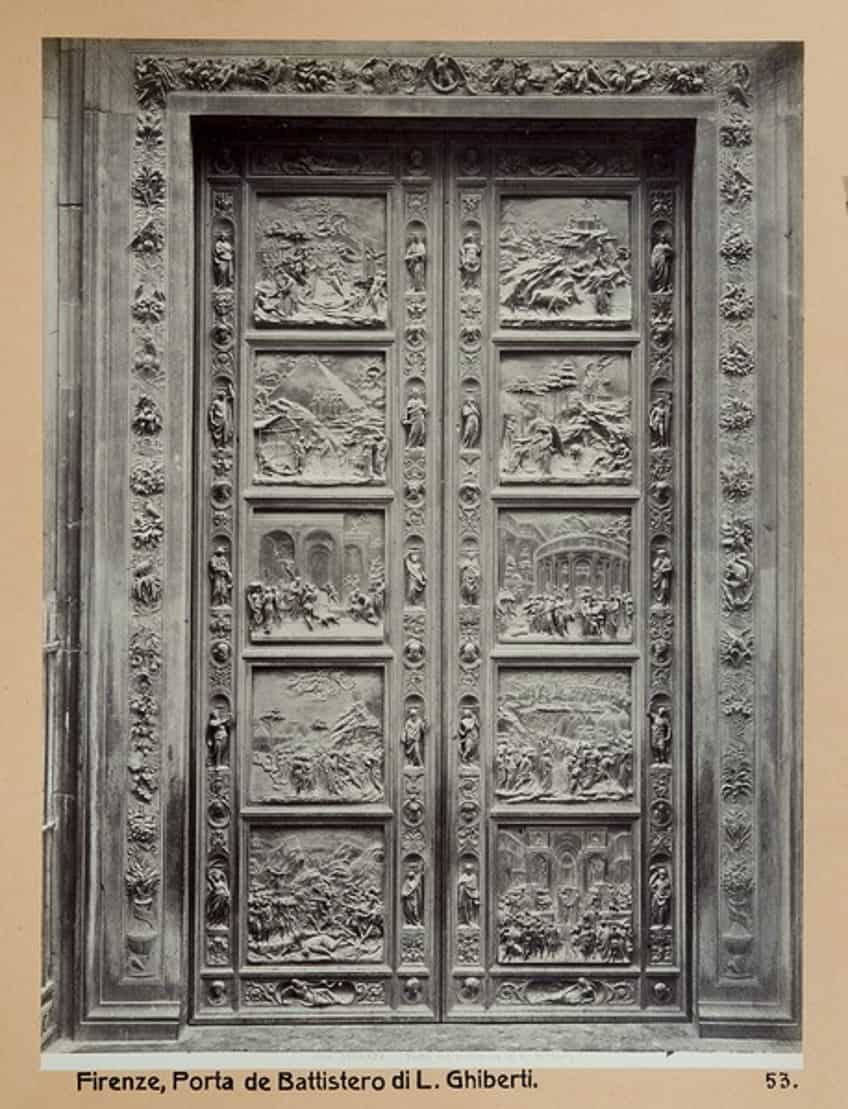
The History of the Famous Bronze Door
Andrea Pisano created the very first two doors of the Florence Baptistry in the 14th century. These doors are made up of 28 panels, with the 20 top panels showing episodes from St. John the Baptist’s lifetime. Faith, hope, compassion, modesty, courage, moderation, righteousness, and wisdom are shown in the eight bottom panels.
The city of Florence established a renowned contest in 1401 for the third door (the northern one) in which both Filippo Brunelleschi and Lorenzo Ghiberti competed. The tournament was won by Lorenzo Ghiberti.
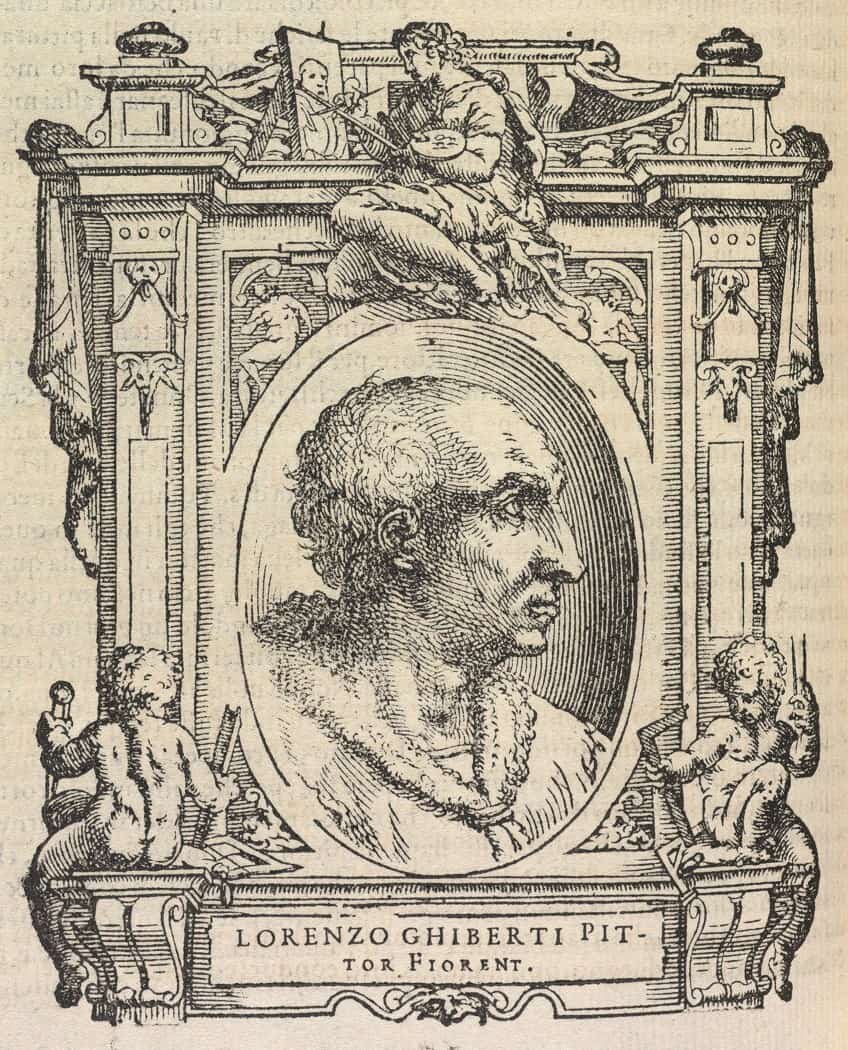
The North bronze doors are made up of 28 panels, twenty of which show the life of Jesus from the New Testament. The four evangelists and the Church Fathers Saint Jerome, Saint Ambrose, Saint Gregory, and Saint Augustine are shown in the eight lower panels.
After completing the North entrance, Ghiberti was given the unique responsibility of also designing the East gate, which ended up being the most magnificent.
The pictures on the bronze doors had to portray the Old Testament, although Ghiberti had complete creative license. The layout was initially supposed to be relatively identical to the other ports, with 28 panels. During the course of this work, He had the notion to create something fresh. Ghiberti chose to decrease the number of panels to 10 while increasing the size, opting for the new square design.
The job demanded the establishment of a specialized workshop, and many notable Renaissance period artists passed through its doors throughout the years.
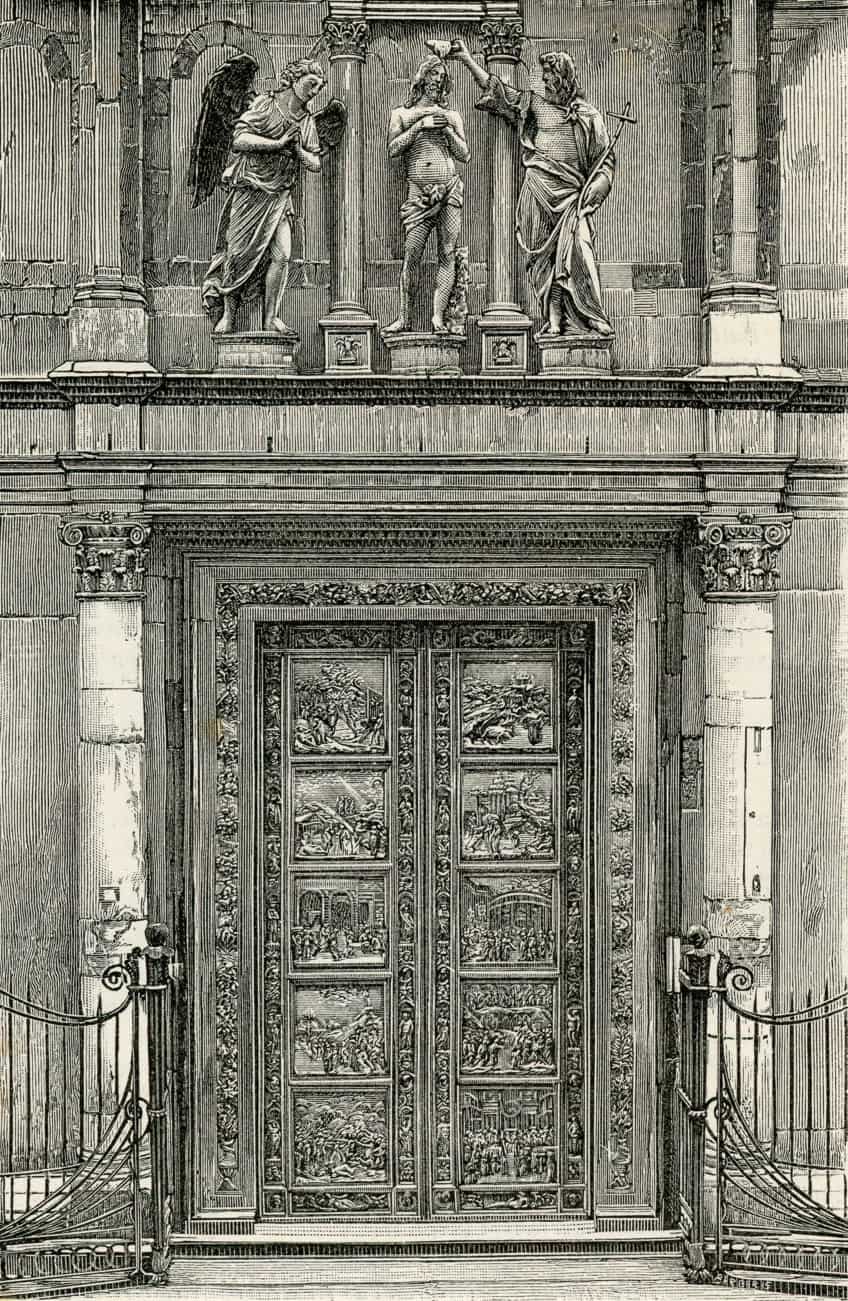
The Scenes Displayed on the Bronze Doors
Each of the panels in this pair of two doors depicts numerous scenarios, all with a similar subject. The Old Testament educated Christian disciples about the lives of certain prominent persons, and Lorenzo Ghiberti would make each panel by selecting numerous instances from each one’s biography. He chose Adam and Eve, Isaac, Noah, Joseph, and Moses as motivation for this astounding show of beauty mixed with technological ability.
These themes may be seen throughout Renaissance art, albeit most painters would create frescoes that focused on a particular tale.
These famous bronze doors were previously known as the East doors, and they joined the artist’s earlier north doors. Michelangelo’s subsequent moniker has proven to be more popular. The previous commission was also located here, although it was relocated once the second commission was complete.
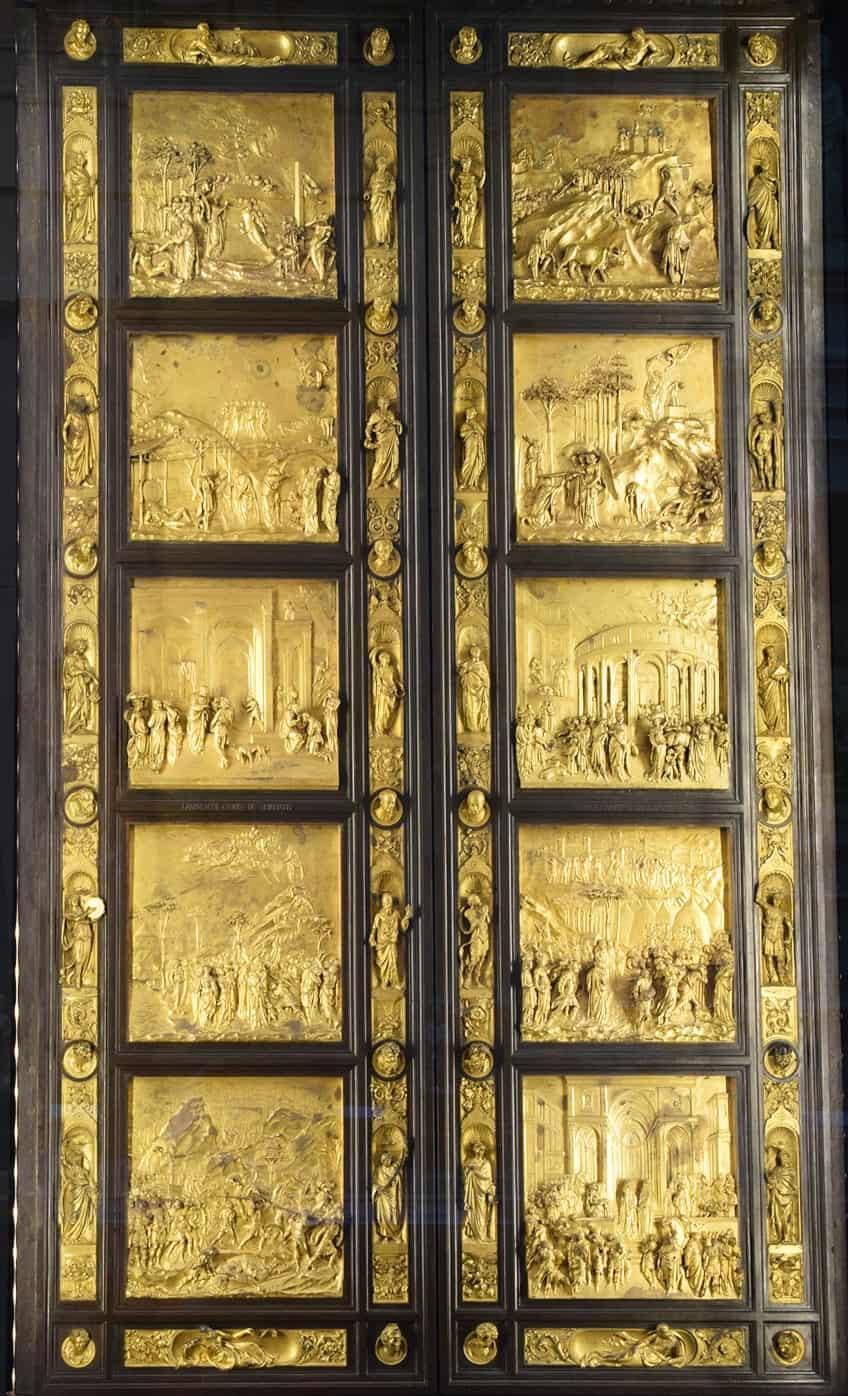
Adam and Eve
For Ghiberti and his workshop helpers, depicting one amazing narrative in each panel felt too easy, so he constructed multiple separate connected events within each one. The entire composition is based on the Book of Genesis’ subject of creation, with discrete scenes illustrating the creation of Adam and Eve, as well as their temptation and exile. Each panel has the same proportions in order to maintain a uniform layout for the doors. The media, gilded bronze, is also the same for both.
Bronze was extremely expensive at the time, but Ghiberti was regarded in such high regard by his benefactors that he was able to seek adequate cash to manufacture everything he desired.
Many painters’ works from the Renaissance period depict Adam and Eve, often from the genesis story and some from other parts of their tale. The bronze doors are still on display at the Baptistry in Florence, rendering them one of the very few masterpieces in the world that have remained in their original position.

Cain and Abel
Another prominent motif from Christian beliefs that have been utilized as motivation by Renaissance and Baroque painters is Cain and Abel. This panel depicts numerous scenes from Cain and Abel’s narrative. You might recognize each of these narratives: Adam and Eve next to their camp, Abel guarding his flock, the tributes made by Cain and Abel, Cain eventually slaying Abel, and God expelling Cain forever.
The entire sequence of panels took 27 years to finish, due in part to the previous commitments made to this in-demand creator.
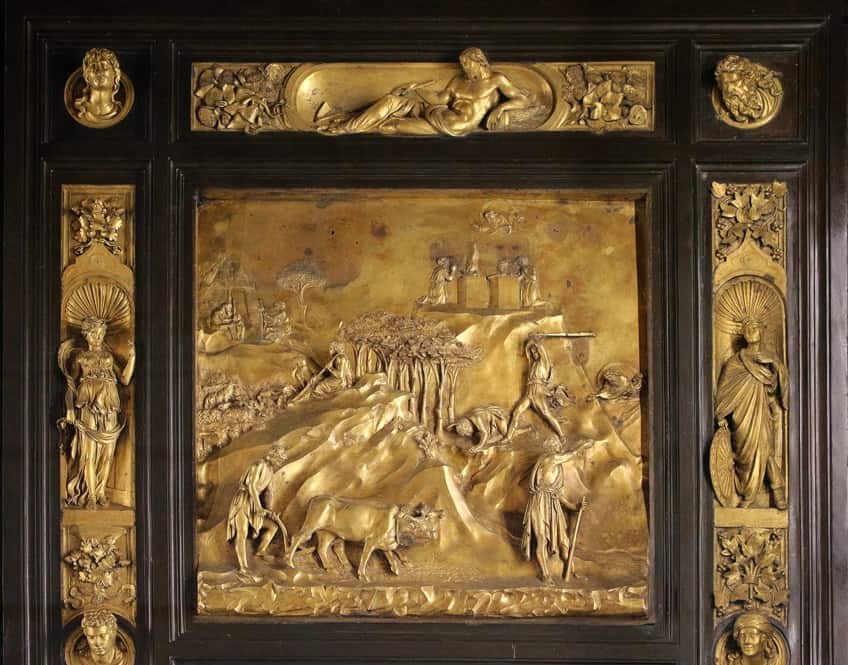
The Drunkenness of Noah
The basic topic of this painting is the fall of mankind, reflecting the content of the Adam and Eve panel. Noah lays beneath a wooden roof, probably inebriated, in the bottom left of the tableau. The ark is represented by the pyramid form above, with various species roaming about its boundaries, waiting to be permitted aboard for the epic trip described in Christian teachings.
Because of the uniform format of these doors, each design is gilded bronze, providing an inspiring finish, especially when all of the panels are joined together.
Bronze was significantly more pricey than stone at the time, but Ghiberti was a master of bargaining and gauging how much respect he had from his donors. Lorenzo Ghiberti made a huge impression with his bronze doors. Sculpture was an important aspect of the early Renaissance period, and this artist would influence modifications in viewpoint and portrait technique.
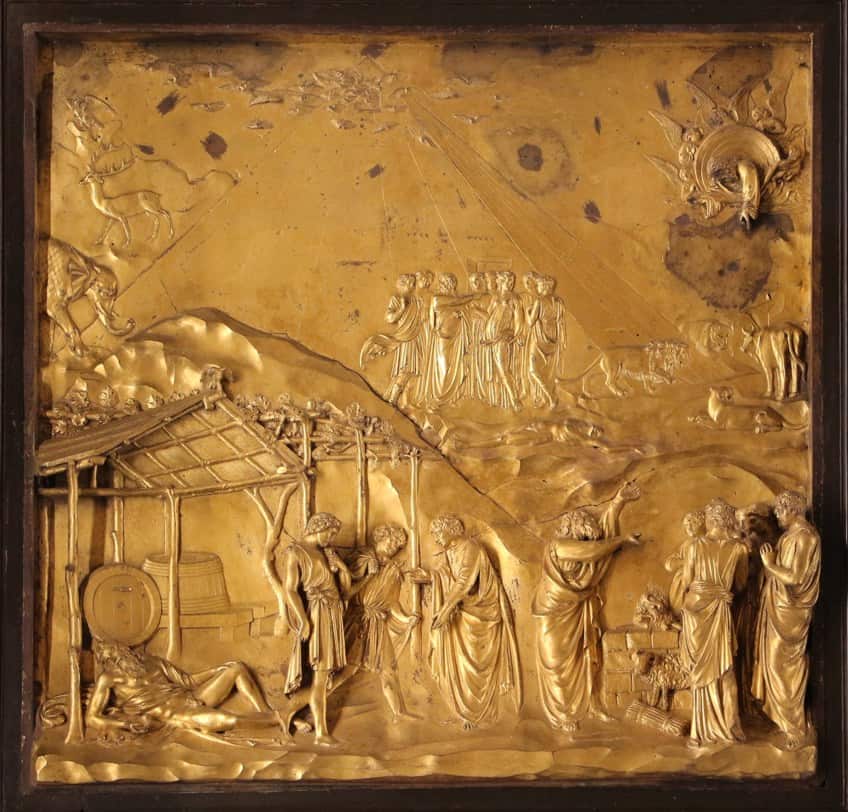
Abraham and Isaac
In the backdrop, you’ll discover the narrative of the Sacrifice of Isaac, which foreshadows Christ’s final tragedy. The unveiling of the Trinity is in the forefront, and Sarah’s supper foreshadows the creation of the Eucharist.
The precision in the trees that sit boldly at the rear of the picture, as well as the stones in the lower right, assist to drive the picture out towards the spectator, which are some of the noteworthy elements of this specific panel.

Isaac With Esau and Jacob
Architectural structure was one area that expanded significantly throughout the Renaissance, and there are early indications of Lorenzo Ghiberti’s pioneering use of viewpoint in this panel. The front of this artwork depicts a plethora of individuals forming several settings, all of which are relevant to the overarching topic. Because of the innovative nature of these pair of doors, a replica of them is frequently found in their original location, in order to conserve the original for future generations.
Ghiberti wanted to create artistic interpretations of the ancient Bible stories that felt genuine and powerful, and he believed that viewpoint was one way he might do so.
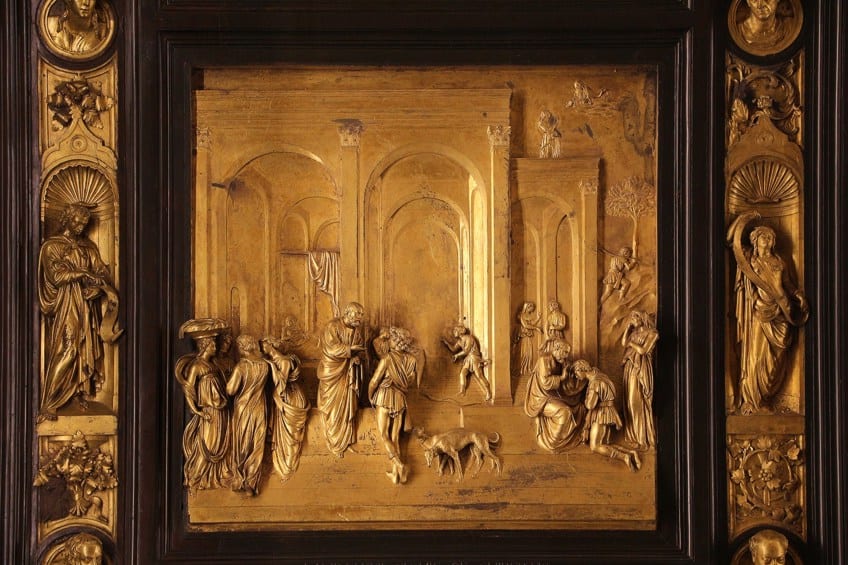
Joseph Sold Into Slavery
This artwork is intimately related to the previously described Jacob and Esau, with the parents shown in that panel bearing sons who appear in this panel. The book of Genesis devotes the most attention to Joseph, detailing his birth and ensuing years in excruciating detail. Joseph’s connection with his brothers causes the most strife, which explains why they all figure in this panel painting.
“Joseph Sold into Slavery” demonstrates the artist’s mastery of perspective, which he would utilize to stretch out his panels to give them a more three-dimensional appearance.

Moses and the Ten Commandments
In the front, you can see all of Israel’s clans gathering at the base of the mountain to witness this momentous event. The rocky mountain, with its sculptured surface extending out from the image’s surface to give it a three-dimensional appearance, may catch the attention first. The attention will then be drawn to Moses and his encounter with the skies, which is the story’s main point.
The plethora of individuals at the bottom adds to the intrigue while also allowing Ghiberti to demonstrate his remarkable portraiture talents.
The trees in the foreground are also in his signature style, with long, slender trunks and ornamental foliage at the top. Within the Christian church, the Ten Commandments were extremely important because they provided a moral foundation. While life cannot be reduced to a ten-point checklist, it did help us to grasp some of the most significant principles on which to base our own actions. Perhaps Michelangelo’s personal admiration for these panels served as the basis for his own Moses statue, which is regarded as one of the artist’s best sculptures in a career marked by diversity and technical mastery.

Joshua and the Fall of Jericho
According to Joshua, once the Israelites had attacked and blasted their horns around the citadel, the fortifications of Jericho would collapse. The outline of this narrative may be seen in this artwork, which has an architectural backdrop in the background and a slew of characters in the foreground, all of whom appear to be discussing rather than fighting at the time.
This is one of the most intricate panels, with a visual appeal extending all the way across the bronze panel.
The lovely tents are possibly the most stunning aspect of this panel, with the walled city in the distance demonstrating the artist’s improving understanding of architectural settings and effectively fitting perspective into artworks. The only way to properly appreciate the magnificence of this artwork, as well as the other panels on these doors, is to see it in person and examine it from various perspectives. Inside this panel, Ghiberti would also most likely have some assistance from his helpers, but he would always assume leadership of the composition and tackle the most essential aspects of each panel himself.

David and Goliath
Many participants of the Italian Renaissance period were affected by the story of David and Goliath, with the notion of the underdog triumphing becoming popular. The disparity in stature between the two soldiers is depicted in a very realistic way by Ghiberti, who places them at the base of this panel. Multiple warriors from both sides watch in wonder as David defends his village by murdering Goliath after reaching an agreement ahead of time.
On the upper part of the panel, their town stands in the backdrop, seemingly oblivious to the sacrifices made in its honor. In order to divide the two sides of the composition, Ghiberti employs a rocky terrain in the middle, with some extra trees to soften the space beneath the rocks.
This panel may be found at the lower-left corner of the bronze doors, also known as the East Doors. When this second series was finished, Ghiberti’s initial series was renamed the North Doors.
The panel across from this one depicts Solomon and the Queen of Sheba, who symbolized the fusion of east and west, and may have been a political decision by those who funded the entire set of doors. Because the Renaissance landscape was so broad, David and Goliath may be found in a variety of genres. Sculptures and frescoes are the most common examples.

Solomon and the Queen of Sheba
The wedding scene in Solomon and the Queen of Sheba demonstrate Ghiberti’s mastery of viewpoint in the background and have a multitude of characters in the front. The eye is drawn straight down the middle of the viewpoint, which is flanked on either side by delicate pillars. From the center to the back, a double flight of steps rises up. This panel, like the others in the Gates of Paradise, is constructed of gilded bronze and is 79cm tall and broad.
Because of the three-dimensional properties of these panels, the architectural components would generally be quite flat, with just the lines suggesting perspective. The characters in the front would be carved deeper, letting them stand out from the rest of the artwork and provide more interest.
There is a slew of characters vying for a peek at the symbolic union of Eastern and Western faiths through Solomon and the Queen’s encounter. This image is said to depict the assembly on the steps of Il Duomo in Florence on the 9th of July, 1439. At that period, Italy was a jumble of republics, and accords like these were vital to consolidate power and avert invasion.
Few painters had depicted anything like this at the time, therefore it was most likely a political choice to include it in the final arrangement of panels. Ghiberti, a forceful temperament who would generally insist on his own preferences, may have made one unusual concession. In that manner, the other panels blend numerous distinct biblical scenarios on each one, rendering this inconsistent.

Conservation of the Gates of Paradise in Florence
The bronze doors have survived a number of disasters since their installation in 1452, including a catastrophic flood, theft, excessive cleaning, and corrosive air pollution. When the bronze doors were initially taken from the front of the Baptistery in 1990 for restoration, they were drab and dirty.
But the most serious damage was happening behind the scenes, practically undetected.
Variations in humidity caused volatile oxides on the metal below the gilding to melt and recrystallize, resulting in minute holes and bubbles on the gold surface, according to diagnostic investigations. When the Arno River inundated Florence on the 4th of November, 1966, six relief panels were pushed off the doors, requiring extensive conservation work.
The exquisite gilded bronze doors of the Baptistery’s east doorway in Florence are among the Italian Renaissance’s foundational monuments. Among the surrounding frames, Ghiberti set 10 magnificently depicted Old Testament episodes. All demonstrate Ghiberti’s singular ability to blend compositional power with the finest delicacy, resulting in rich graphic effects and viewpoints hitherto unseen. Ghiberti’s workshop required 27 years to design and build the gigantic doors, and the subsequent conservation effort to restore them to their former glory has taken an equal length of time.
Frequently Asked Questions
Who Created the Gates of Paradise in Florence?
Lorenzo Ghiberti began his career as a goldsmith, but he immediately became known in Florence for his skill in bronze sculptural work, which was a valuable and expensive medium at the time. In 1401, the city of Florence held a well-known competition for the third door, in which Filippo Brunelleschi and Lorenzo Ghiberti participated. Lorenzo Ghiberti took first place in the competition.
What Is Displayed on the Gates of Paradise?
Each of the panels in this set of two doors displays a variety of settings, all of which have a common theme. The Old Testament taught Christian disciples about the lives of famous people, and Lorenzo Ghiberti would create each panel by choosing various examples from each person’s history. He picked Adam and Eve, Isaac, Noah, Joseph, and Moses to be the inspiration for this breathtaking display of beauty and scientific prowess.
Isabella studied at the University of Cape Town in South Africa and graduated with a Bachelor of Arts majoring in English Literature & Language and Psychology. Throughout her undergraduate years, she took Art History as an additional subject and absolutely loved it. Building on from her art history knowledge that began in high school, art has always been a particular area of fascination for her. From learning about artworks previously unknown to her, or sharpening her existing understanding of specific works, the ability to continue learning within this interesting sphere excites her greatly.
Her focal points of interest in art history encompass profiling specific artists and art movements, as it is these areas where she is able to really dig deep into the rich narrative of the art world. Additionally, she particularly enjoys exploring the different artistic styles of the 20th century, as well as the important impact that female artists have had on the development of art history.
Learn more about Isabella Meyer and the Art in Context Team.
Cite this Article
Isabella, Meyer, ““Gates of Paradise” by Lorenzo Ghiberti – The World-Famous Bronze Door.” Art in Context. June 17, 2022. URL: https://artincontext.org/gates-of-paradise-by-lorenzo-ghiberti/
Meyer, I. (2022, 17 June). “Gates of Paradise” by Lorenzo Ghiberti – The World-Famous Bronze Door. Art in Context. https://artincontext.org/gates-of-paradise-by-lorenzo-ghiberti/
Meyer, Isabella. ““Gates of Paradise” by Lorenzo Ghiberti – The World-Famous Bronze Door.” Art in Context, June 17, 2022. https://artincontext.org/gates-of-paradise-by-lorenzo-ghiberti/.







